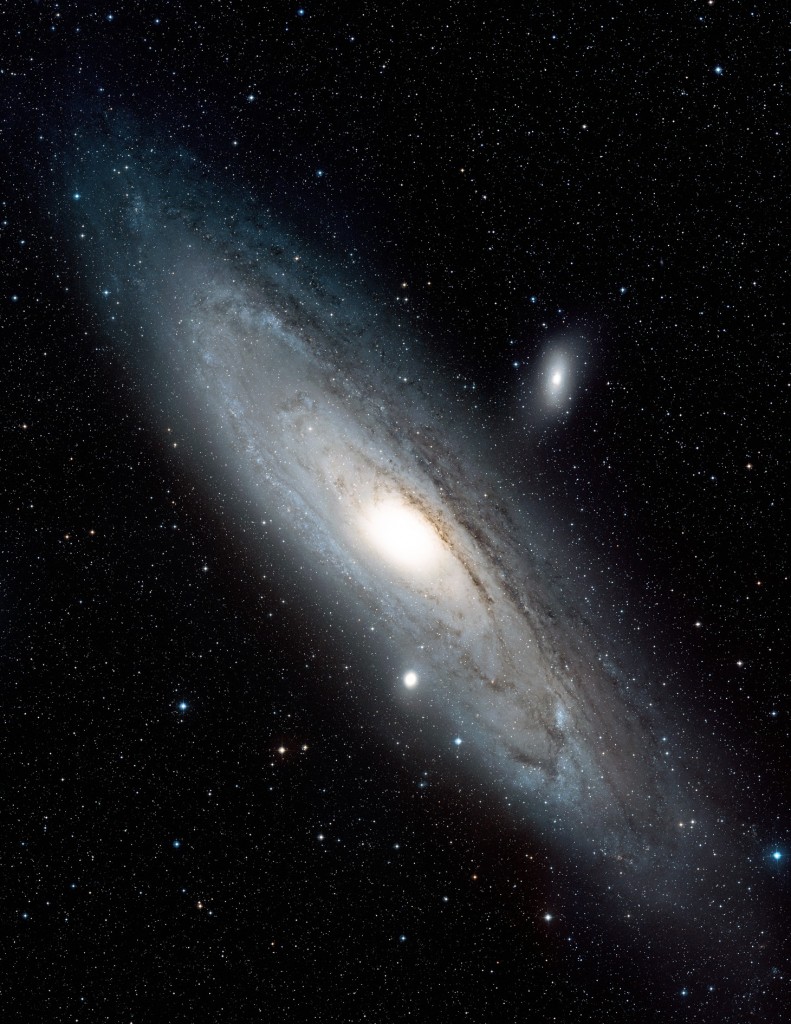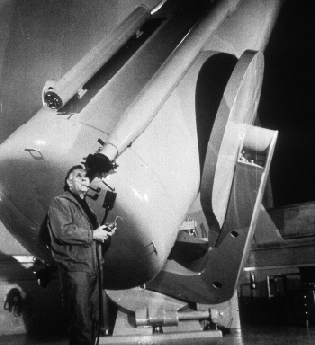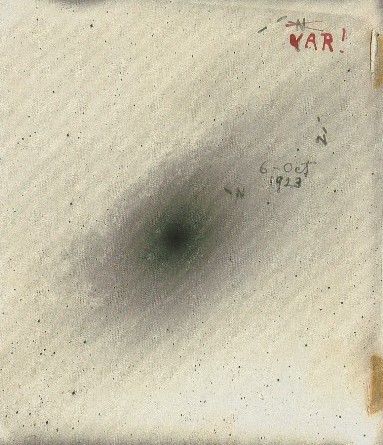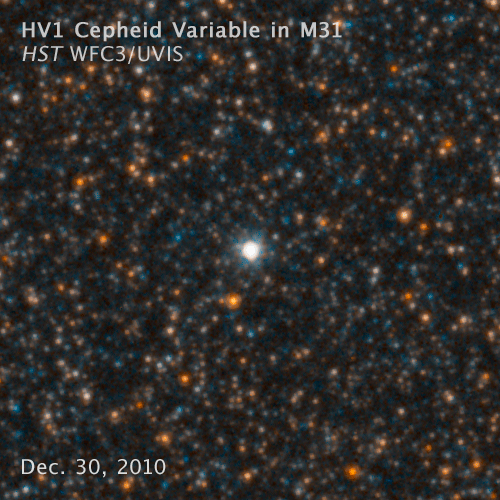This essay originally ran in 2011. Back then, the Hubble Space Telescope was the exemplar of non-Earth astronomical observation. Its successor, the James Webb Space Telescope, launched in December 2021. This anecdote, however, might be timeless.
In 1984, David Soderblom was a new hire at the Space Telescope Science Institute in Baltimore, and one day he got to thinking. STScI was—and still is—the science and operations center for the Hubble Space Telescope, which was then scheduled to launch in 1986. Soderblom suggested that a memento of some sort be aboard the space shuttle delivering HST into orbit—something, he recently told me, “to tie Hubble the man to Hubble the telescope.”
His first thought was a pipe. In photographs, Hubble always seemed to have a pipe pinched between his teeth, even when observing at the eyepiece of the 200-inch Hale telescope on Palomar Mountain—or at least when posing at the eyepiece. Soderblom contacted Allan Sandage, the onetime assistant of Hubble who, upon Hubble’s debilitating heart attack in 1949 and death in 1953, became his de facto heir at the Mount Wilson and Palomar Observatories (now the Carnegie Observatories) in Pasadena. Sandage told Soderblom he had a better idea. What about the photographic plate with which Hubble had made the discovery that essentially began modern cosmology: that our vast menagerie of stars is not alone but is, as we now know, merely one among billions of galaxies clouding the universe as far as even HST would be able to see?
This anecdote was part of an STScI press release distributed at this past May’s meeting of the American Astronomical Society, in Boston, to accompany a presentation of a series of observations by Hubble-the-telescope commemorating this discovery by Hubble-the-astronomer. But, as Soderblom and I found during a conversation a couple of weeks ago, there’s more to the story.
To begin at the beginning:
On October 4, 1923, while observing with the 100-inch Hooker telescope on Mount Wilson, Hubble took a photograph of the Great Andromeda Nebula, or M31 in the classification system of 103 nebulae that Charles Messier published in 1781. (Messier was trying to help astronomers distinguish between smudges and comets.) Hubble thought he noted a “nova,” or new star, so he returned to M31 the following night and took a 45-minute exposure of the same spiral arm. When he got back to his office, he began comparing the new plates with other photographs of the nebula on a number of different dates and found that the nova was actually a variable, a kind of star that, as its name suggests, varies: It pulsates, brightening and dimming. More important, it was a Cepheid variable, the kind of variable that brightens and dims with clockwork regularity.
A Cepheid variable was what Hubble was hoping to find. In 1908, the Harvard astronomer Henrietta Swan Leavitt had discovered a proportional relationship between the pulsation period of a Cepheid variable and its intrinsic brightness: the longer the period, the brighter the variable. If you know how often a variable pulsates, then you know how bright it is relative to other variables; if you know how bright it is relative to other variables, then you know how distant it is relative to other variables. When Hubble compared the pulsation period of the Cepheid variable he’d found in M31 with the pulsation periods of other Cepheid variables, he concluded it was at sufficient distance that it (and therefore its host nebula, M31) lay beyond what astronomers of the day called “the island universe”—or, as they would now have to reconceive it, our island universe, the Milky Way galaxy.
Hubble went back to H335H, the photographic plate he made on the night of October 5 to 6, crossed out the “N” he’d used to designate the “nova,” and added a celebratory “VAR!” In doing so, he created one of the iconographic astronomical images of the twentieth century.
It was this relic that Sandage, at Soderblom’s behest, delivered to NASA in the mid-1980s.
But the idea of launching a historic photographic plate into space didn’t sit well with Soderblom (and he suspected that sending unnecessary glass into space wouldn’t sit well with NASA). So he suggested photographing the plate, producing fifteen negatives, and sending ten aboard for later distribution as tokens of thanks to sponsoring organizations. The negatives would travel in official flight kits—the facilities where NASA stores keepsakes. In 1990, the space shuttle Discovery loosed HST into orbit and returned to Earth with its “VAR!” cargo intact.
Then, disaster. The imperfections in HST’s primary mirror made the observatory a global laughingstock, and its cache of accompanying commemorative mementoes—the miniature flags and patches and pins, as well as Soderblom’s negatives—an afterthought.
About four years ago, Soderblom got to thinking about the upcoming fifth and final servicing mission to HST. And he got to thinking about those ten negatives. Maybe he could locate them and store them aboard the space shuttle that would be visiting HST one last time. He liked the “symmetry” of the negatives flying aboard the first and final HST shuttle missions.
By this time, of course, HST’s early ignominy was nearly forgotten. So too, alas, were the negatives. Soderblom contacted the person at the Johnson Space Center in Houston who was in charge of official flight kits. She said she would have to check the vault.
“Okay, that’s cool,” Soderblom thought. “I’ve got a desk drawer. She’s got a vault.”
The search, however, came up empty. Still, Soderblom figured, he at least had the remaining five negatives. He arranged to store two aboard Atlantis during the final mission to HST, in May 2009.
But then Soderblom got to thinking yet again. What if Hubble-the-telescope observed what Hubble-the-man had photographed on a fateful October night in 1923—the celestial object that astronomers call Hubble variable number 1, or V1? Locating V1 would be difficult and time-consuming, so the Hubble Heritage Project appealed to the American Association of Variable Star Observers (AAVSO). Between July and December 2010, eleven amateur astronomers made 214 observations of V1, allowing the Hubble Heritage team to target the variable at its brightest and dimmest phases: December 17, 21, and 30, and January 26—the achievement that Soderblom, the Harvard historian Owen J. Gingerich, and representatives from the Hubble Heritage Project and the AAVSO celebrated at the May meeting of the American Astronomical Society.
End of story? Not quite. When Soderblom and I spoke by phone earlier this month, he said he had a question. We were talking because we had heard through a mutual friend that we both had an interest in the “VAR!” plate. Soderblom wanted to know if I had actually held the plate in my hands.
Yes, I said. In May 1999, I was interviewing Sandage in his office at Carnegie Observatories when he reached into a file cabinet and produced the plate.
Soderblom said he had another question. Was the scrawled “VAR!,” as he’d often heard, actually in red ink?
Yes.
“That’s really interesting,” he said, italics hardly doing the drawn-out word justice.
First, he said, this information confirmed for him that he’d never held the plate himself. Over the decades his memory had lost track of how the plate had arrived—whether Sandage had delivered it to STScI in person or through a courier (the U.S. Postal Service?!, he sometimes scared himself, retroactively). But now, he said, the red—the red he would have remembered.
This fact, however, also helped him understand an issue of greater historical import. Hubble had written “6 – Oct 1923” below “VAR!,” yet the custom at the time was to write such information on the opposite side of the plate, along the border. And indeed that’s where Hubble had written the date—though the date he wrote there and in his notebook was Oct. 5, reflecting Pasadena time. The “6 – Oct” inscription followed the astronomical convention of using Universal Time, or Greenwich Mean Time, but to an astronomer’s eyes it would have been, Soderblom said, “redundant information.” Hubble, he had always suspected, must have written it there “for display purposes”—a hunch, he added, that Hubble’s use of posterity-radiant red for “VAR!” certainly supported.
![]() I told Soderblom that Sandage must have had the same hunch. When Sandage handed me the plate, he, too, had noted the color of Hubble’s “VAR!”
I told Soderblom that Sandage must have had the same hunch. When Sandage handed me the plate, he, too, had noted the color of Hubble’s “VAR!”
“In red, he wrote it,” Sandage had said. ”He knew reporters were going to come and look at this.”
Soderblom and I laughed. I’d never noticed the incongruity of the placement of the date. He’d never been sure about the red. Not that either piece of information changes the historical record regarding the science.
But together they do leave little doubt: Hubble the man was, in the end, only human.
* * *
Credits (top to bottom): ESA/Hubble & Digitized Sky Survey 2 (acknowledgment: Davide De Martin, ESA/Hubble); Mt. Wilson Archive, Carnegie Institution of Washington; Carnegie Observatories; Carnegie Observatories; NASA, ESA, and the Hubble Heritage Team (STScI/AURA).




This is just surprising and lovely. I’m delighted to have read it.
Now please tell us what the rest of those number mean. Was that 3 arcseconds of seeing? If so, that’s reasonably bad, right?
Thanks Richard, nicely written. I worked on the recent HST observations of V1, an interesting project given the ultimate importance of Edwin Hubble’s Mt. Wilson observations and conclusions.
One interesting numerological tidbit is that HST’s mirror is roughly the same size (94 inches or 2.4m) as the Mt. Wilson Hooker Telescope’s (100 inches). HST’s power is achieved because of its location outside the atmosphere and tremendous advances in instrumentation.
Another demonstration of the dramatic changes in technology over the last century or so is that amateur astronomers with fairly modest instrumentation can now routinely resolve V1 and measure its variability quite precisely. Such observations, coordinated by AAVSO, allowed us to schedule the HST observations near the minimum and maximum of the light curve.
Ann: It’s not great, but I’m no expert on seeing conditions.
Zolt: Great points to make. Thanks very much.
nice anecdote, richard. i like the last figure, with the brightness of V1 at 4 times. is there a way to stop the movement at each stage, or at lesat to slow it down? my old brain doesn’t work that fast.
speaking of the figure, i want to say how much i admire the graphics in LWON. they are fully up to the quality of the writing. kudos to whoever did the initial design of the site and whoever obtains and inserts all those great photos. it makes the whole endeavor look so professional!
The seeing “3” is not in arcseconds. Mt. Wilson had a unique system of estimating the seeing. It was a scale from 1-6 (if my memory serves me). Seeing 6 was the best and 1 was the worst. There was a seeing scale associated with it, but the scale was based on how a guide star looked. For instance I remember one of the numbers corresponded to sharp image with significant halo. As one of the last of the Mt. Wilson observers, it was fun to use this seeing scale, feeling that we were taking part in a history that was soon going to end.
Nick: Thanks for the information.
Skeptico: Thanks for your comment. I don’t know how to stop the image–sorry. Maybe follow the credit at the end of the column: Carnegie Observatories; NASA, ESA, and the Hubble Heritage Team (STScI/AURA)
Heather Pringle is primarily responsible for the original design of the site. The writers choose their own photos. Thanks for letting us know that you like our looks!
Nicholas: Oh, thank you! I hadn’t known that at all. In any case, it wasn’t terrific seeing, right?
Skeptico: Don’t think there’s a way to stop the animation in that particular graphic (ti’s a simple animated GIF), but you can see the four separate still images at http://hubblesite.org/newscenter/archive/releases/2011/2011/15/image/a/format/web_print/
Skeptico, you can download (right click) the gif and run a program that does have a button to slow it down. xanim knows how to do it, which is what i use. a cursory google search shows this is a common problem with a number of solutions.
The Mt Wilson seeing scale is give by Babcock (1963), PASP, 75, 1. It is not quite what I remember in the 1980s because the scale I had only went up to 6. The 1963 paper had the scale from 1 to 8. btw, this paper shows how brilliant Horace Babcock was in instrumentation. Even today, this is a totally cool idea.
The Mt Wilson scale:
1 – Diameter 3-5″ blurred
2 – Image blurred, 2-3″
3 – Image diameter 1-2″, tremulous
4 – Image sharp, about 2/3″, slight tremor
5 – Diameter 1/2″, little motion
6 – Diameter 1/3″
7 – Diameter 1/4″
8 – Image virtually motionless, round, steady, diameter 1/5″
This is almost like poetry to me. I have not read this list in 30 years and now I remember it (up to scale 6) exactly. I loved the word tremulous in the scale.
Most of the time I had seeing 4. I recall only one plate I borrowed from the Baade plate collection with scale 6, and it was taken on a sheet of Eastman “E” film around 1930 by Shapley.
Oh now I’m in love with Babcock. I was already in love with him for thinking up adaptive optics, which seems absolutely brilliant to me. But now that he wrote poetry too? Be still, my heart. Virtually motionless, slight tremor, tremulous, blurred — next stop, explosion into sparkling pieces.
Thank you so much. So VAR! was tremulous, was it? And used to expand the universe? I just re-read the scale and am in love all over again.